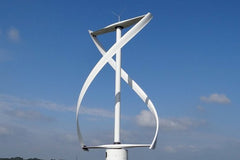Articles
F1 boffin’s turbine is a thing of beauty – whatever the weather! May 05 2015
David Derbyshire – The Sunday Times (30/3/14)
A decade ago Michael Blaize was devising ways to make gas-guzzling Formula One cars go faster. Now the engineer is the brains behind a slimline wind turbine that could usher in a new era of low-carbon public transport.
His invention, an elegant structure in curved carbon fibre that resembles the double helix of DNA (see image below), is billed as the most advanced vertical axis turbine in the world. Revolutionary – excuse the pun!

“The design is smaller, quieter and easier to maintain and less offensive to the eye than traditional wind turbines” Blaize claims.
A full-sized prototype is being put into production soon and within two years five test turbines should be up and running. If all goes to plan then thousands of them could be installed alongside railways in an attempt to generate 70% of the network’s electricity needs!
Vertical-axis turbines, in contrast to regular conventional wind turbines, can spin no matter which way the wind blows making them ideal in places that wind is changeable. With a much smaller footprint they can be installed more densely and their simpler design makes repair and maintenance much cheaper.
It has two spiral blades, arranged in a double helix, and can generate electricity for 13 homes. It is 19 metres tall and sits on a 30 metre mast, making it as high as an electricity pylon. It spins at up to 60 revolutions a minute, starts with wind speeds of 8mph and stops at 56mph. Blaize’s prototype – XW-80, was created to bridge the gap between small-scale vertical axis turbines generating 10kW or so and the giant horizontal axis 10MW machines used in commercial wind farms. Tests on a smaller 6kW model installed on the Isle of Wight last year showed it performed comparably to traditional horizontal axis turbines but at lower wind speeds and closer to the ground.
Blaize claims that “The design could help to get around some of the objections of the anti-turbine lobby. It provides clean energy but with a much lower visual impact and its smaller scale is more appealing to look at.” This, along with it being quieter and easier to maintain makes it ideal for sites with restricted access or limited space.
His long term goal is to have 12,000 turbines installed along Britain’s railways. Network Rail are very interested in getting involved in the two year project to develop these turbines. An initial investment of £1.5bn could save them around £3.8bn in energy over 30 years. He is targeting the end of March 2015 as the date by which two turbines should be in operation.
Britain is in the middle of an extraordinary boom. During the month of February, wind farms generated a record 11% of the country’s electricity, 2.7GW - which is enough to power 6.5m homes. Concerns over the gas supply from Russia have focused our attentions on the instability of imports. We need a stable domestic energy sector. David Milborrow, technical adviser to Renewable UK and a wind-power expert stated “X-Wind Power have clearly solved some of the problems that have hampered previous designs and if they point to performance results from its 6kW turbine, it will be in a strong position.”
Note: Another company capatalising on Formula 1 technology, namely the scientists from the team that invented the Blown Diffuser on the Brawn Formula 1 car (now the Mercedes team) have also established a new technology company which claims to be able to generate increased output at low wind speeds - see Anakata Wind Power Resources for details.
